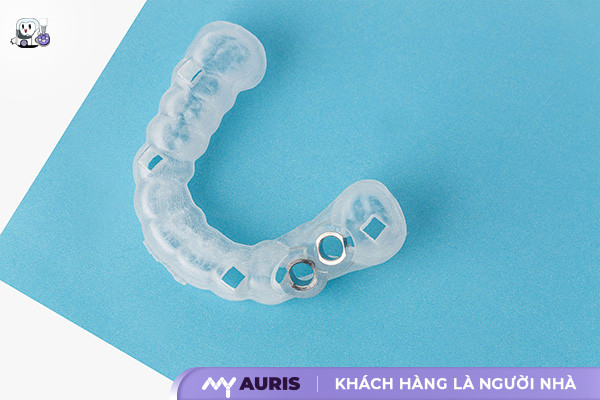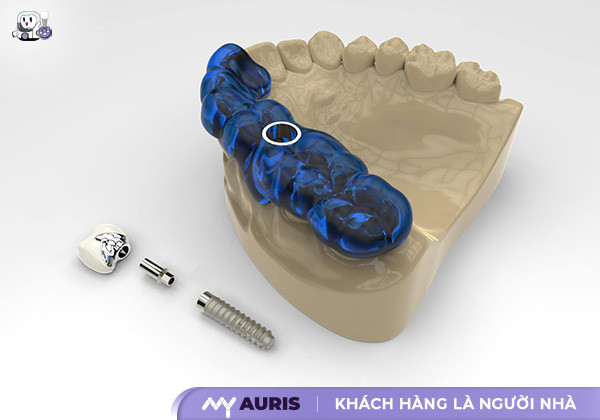Previously, implant placement techniques primarily relied on the dentist’s personal experience, which sometimes led to inaccurate positioning and angulation of the implant post, affecting the effectiveness of the subsequent restoration. However, with the advancement of modern digital technology, surgical guides have become a powerful tool for implant surgery, supporting precise positioning and angulation of the implant post, minimizing errors during the procedure.
During manual implant placement, there’s a risk of the implant post being misaligned or incompatible with the future prosthetic tooth. But with the support of a surgical guide – a device custom-designed for each patient using specialized software – the dentist only needs to drill exactly according to the pre-calculated position. This not only ensures safe and precise implant surgery but also shortens treatment time and increases the success rate.
Things to Know About Implant Surgical Guides
An Implant surgical guide is a 3D-printed dental instrument, typically made of transparent plastic or metal, designed based on ConeBeam CT scans and the patient’s dental impressions. The main goal of the guide is to help the dentist accurately determine the position and angulation for implant placement, thereby enhancing precision and safety during the surgical procedure.
The basic structure of the guide consists of 3 components:
- Guide base: This part rests on the teeth, mucosa, or jawbone, functioning to keep the guide stable throughout the surgical procedure.
- Main guide sleeve: Used to determine the implant placement position and angulation, assisting the dentist in placing the implant more accurately than with manual methods.
- Guide pins/screws: These secure the guide, preventing it from shifting or moving during surgery, especially useful in cases where the patient has lost many teeth and lacks clear reference points.
The support from implant surgical guides helps dentists place implants more accurately, minimizes errors, and shortens treatment time. However, it’s important to note that even with guide assistance, establishing an effective and safe implant placement plan still largely depends on the skilled and qualified dentist. Only when performed by an experienced team can the implant procedure ensure long-term success and avoid unwanted complications.

Precision Surgical Mechanism of the Surgical Guide
In the field of implantology, the Guideline surgical guide – also known as X-guide – plays a crucial role in accurately translating the treatment plan from software to the actual oral cavity. This is a significant advancement in enhancing the safety and effectiveness of the surgical procedure.
Thanks to the application of modern technology, Guideline’s precise surgical mechanism helps minimize discrepancies between the plan and reality. The synchronization between planning software and practical execution allows the dentist to fully control the depth, angulation, and position of the implant during the procedure.
A key feature of this system is the Client positioning sleeve system along with a specialized surgical kit. The Client’s role is to create precise guide sleeves, allowing the drill bit to slide within them, thereby ensuring no deviation in direction while controlling the drilling depth – neither too shallow nor too deep.

Advantages and Disadvantages of Surgical Guides in Implant Placement
In modern implantology, surgical guides are powerful supportive tools that enable precise implant placement, significantly increase success rates, and ensure maximum patient safety.
Advantages of implant placement using surgical guides:
Support for treatment planning of missing tooth restoration: Thanks to pre-prosthetic design and simulated mock-ups using 3D design software, the dentist can precisely determine the ideal position for implant placement. This avoids the situation of choosing the thickest bone area for implant placement without considering the final restoration, which could lead to minor misalignments causing difficulties in subsequent prosthetic work.
Simulated prosthetic design using computer software helps determine the exact implant angulation, which then guides the precise implant placement position through a 3D-printed surgical guide. When applying surgical guides for implant placement, the surgical procedure proceeds exactly as planned.
Preserves anatomical structures and minimizes invasiveness, thereby shortening healing time, reducing post-implantation swelling, alleviating post-implantation pain, and enhancing implant integration.
Faster surgery, while also helping to avoid damage to nerves, sinuses, or adjacent teeth. As a result, the final aesthetic outcome is significantly improved, especially when the entire prosthetic plan has been thoroughly prepared in advance.
Disadvantages of surgical guides:
Requires high-tech equipment: The application of technology such as 3D design software and 3D printers to create surgical guides results in higher treatment costs compared to traditional techniques.
Dentists need skills in using new technology: In addition to implantology expertise, dentists must be proficient in operating software, equipment, and applying new technology to actual treatment.
More cumbersome to operate: Due to the guide’s design, the drill bit must be longer to accommodate the height of the guide sleeve, making it difficult to access posterior teeth and challenging to operate in that region.

Frequently Asked Questions When Using Implant Surgical Guides
The use of implant surgical guides is becoming increasingly common due to its many superior advantages. Below are frequently asked questions when applying this modern method, helping patients understand it better before making a choice.
Can Implant surgical guides be used in all implant cases?
Not all cases require a printed surgical guide. For complex implant cases, such as those requiring bone augmentation, a narrow surgical field, or the presence of removable dentures, the use of a guide will be carefully considered. Conversely, in simpler cases where the bone area is easily observable or precise manual manipulation is possible, the dentist may not need to use a guide. Whether or not to use it depends on the analysis of the exact implant placement position and angulation – all determined by a specialist dentist based on modern computer software to support effective treatment planning.
Does using an Implant surgical guide guarantee successful surgery?
Surgical guides are powerful supportive tools for precise implant placement, minimizing deviations and reducing trauma. However, the key factor remains the dentist’s skill and experience. Furthermore, designing the guide using modern software requires in-depth insight and a thorough understanding of dental anatomy – something only highly specialized dentists can perform well. When applied correctly, surgical guides can maximally reduce errors, shorten surgical time, and preserve dental structures, nerves, and maxillary sinuses, leading to safer and much more accurate results compared to older guide fabrication techniques like resin-based models, which had high inaccuracy and lacked precision.
Which clinic offers safe, reputable Implant placement with modern guides?
To perform effective implant surgery, patients should choose specialized dental centers with a team of dentists with over 15 years of experience, equipped with modern machinery such as CBCT imaging machines, Piezo devices for reduced trauma, PRP centrifuges, PrimeScan 3D scanners, and especially the PIC impression system – all of which help optimize treatment outcomes.
One of the prominent addresses today is My Auris, which applies CAD/CAM technology for 3D printing implant surgical guides – achieving high accuracy, sharp designs, and saving significant time. Dentists here operate quickly and gently, helping to reduce damage to surrounding gum tissue and jawbone, while also minimizing swelling and pain, ensuring patient comfort.





